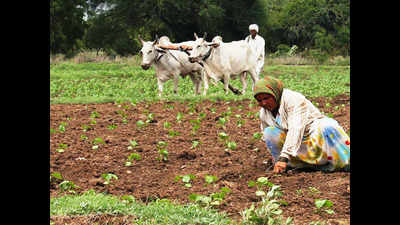- News
- City News
- patna News
- Bihar: Farmers prepare for kharif crops as monsoon sets in
Trending
This story is from June 14, 2020
Bihar: Farmers prepare for kharif crops as monsoon sets in

Photo used for representational purpose only
PATNA: With the India Meteorological Department (IMD) declaring onset of monsoon in the state on Saturday, the sowing of kharif crops would become brisk.
The target area for paddy cultivation this year is 33 lakh hectares, as per the discussions agriculture minister Prem Kumar had with the state, division, district and block-level officials through videoconferencing on June 9.
Similarly, the target area for kharif maize is 4.5 lakh hectares, kharif variety of pulses 1.5 lakh hectares and jute 1.37 lakh hectares.
The agriculture department’s June 9 report has also mentioned that the seeds required for various crops were available in the state. According to it, while 4.89 lakh quintals of paddy seeds are required for sowing, the availability is 4.95 lakh quintals. Similarly, more than required quantity of ‘arhar’ ‘urad’, ‘soyabean’, peanut and jute seeds are available.
Once there are good early monsoon showers and the plots of land are filled with water, the preparation of the part-plots for the sowing of paddy begins in the state and the process is completed by June 20 or so.
Then, after a gap of 18 days, paddy seedlings are uprooted for transplantation from the first week of July. This process is completed by mid-July if parameters like wet and humid weather conditions, backed by adequate rain or water availability, are met.
Although paddy is cultivated in all the 38 districts of the state, there are only 23 districts where the annual yield of paddy is more than 1 lakh metric tonnes. The highest yield is generated in Rohtas district, also called the “rice bowl” of Bihar, followed by Auarangabad and Kaimur.
The top 12 rice-producing districts in the state are Rohtas, Aurangabad, Kaimur, Bhojpur, Nalanda, West Champaran, East Champaran, Supaul, Madhepura, Madhubani, Purnia and Katihar.
The 11 other districts with rice yield in the range of 1 lakh to 2 lakh metric tonnes are Patna, Sitamarhi, Muzaffapur, Samastipur, Darbhanga, Nawada, Arwal, Gaya, Araria, Kishanganj and Banka.
The target area for paddy cultivation this year is 33 lakh hectares, as per the discussions agriculture minister Prem Kumar had with the state, division, district and block-level officials through videoconferencing on June 9.
Similarly, the target area for kharif maize is 4.5 lakh hectares, kharif variety of pulses 1.5 lakh hectares and jute 1.37 lakh hectares.
The agriculture department’s June 9 report has also mentioned that the seeds required for various crops were available in the state. According to it, while 4.89 lakh quintals of paddy seeds are required for sowing, the availability is 4.95 lakh quintals. Similarly, more than required quantity of ‘arhar’ ‘urad’, ‘soyabean’, peanut and jute seeds are available.
“On Thursday, the day was cloudy in our area, but partial rain was received here and there on Friday and the easterly wind has started blowing,” said Abhishek Kumar, a resident of Dhamdaha block in Purnia district, adding farmers have been waiting for the good monsoon showers as it would mark the start of paddy cultivation.
Once there are good early monsoon showers and the plots of land are filled with water, the preparation of the part-plots for the sowing of paddy begins in the state and the process is completed by June 20 or so.
Then, after a gap of 18 days, paddy seedlings are uprooted for transplantation from the first week of July. This process is completed by mid-July if parameters like wet and humid weather conditions, backed by adequate rain or water availability, are met.
Although paddy is cultivated in all the 38 districts of the state, there are only 23 districts where the annual yield of paddy is more than 1 lakh metric tonnes. The highest yield is generated in Rohtas district, also called the “rice bowl” of Bihar, followed by Auarangabad and Kaimur.
The top 12 rice-producing districts in the state are Rohtas, Aurangabad, Kaimur, Bhojpur, Nalanda, West Champaran, East Champaran, Supaul, Madhepura, Madhubani, Purnia and Katihar.
The 11 other districts with rice yield in the range of 1 lakh to 2 lakh metric tonnes are Patna, Sitamarhi, Muzaffapur, Samastipur, Darbhanga, Nawada, Arwal, Gaya, Araria, Kishanganj and Banka.
End of Article
FOLLOW US ON SOCIAL MEDIA










